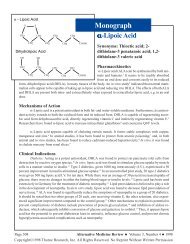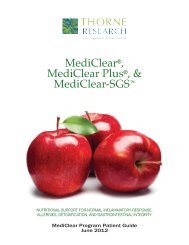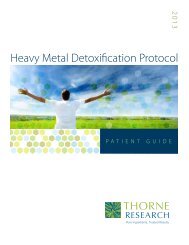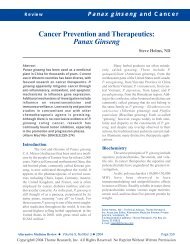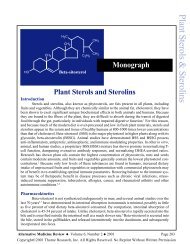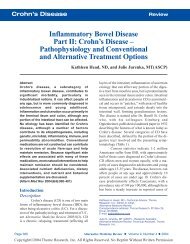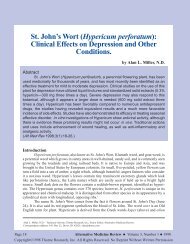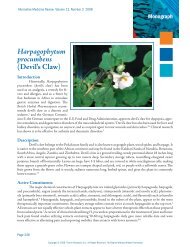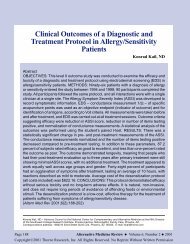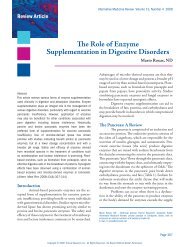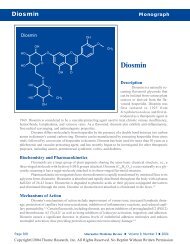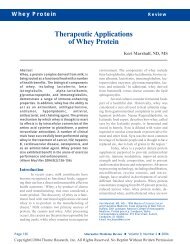Monograph - Thorne Research
Monograph - Thorne Research
Monograph - Thorne Research
Create successful ePaper yourself
Turn your PDF publications into a flip-book with our unique Google optimized e-Paper software.
Policosanol<br />
<strong>Monograph</strong><br />
Saccharum offinarum (Sugar Cane) Harold St.John photo<br />
Octacosanol<br />
CH 3 (CH 2 ) 27 OH<br />
Policosanol<br />
Introduction<br />
Policosanol, an extract<br />
from sugar cane (Saccharum<br />
officinarum L.), has been heavily<br />
researched in Cuba in several human<br />
populations for its cholesterol-lowering properties. In addition<br />
to improving serum lipids, policosanol reduces LDL oxidation,<br />
decreases platelet aggregation, decreases smooth muscle proliferation,<br />
and improves symptoms of cardiovascular disease. Side<br />
effects are virtually non-existent.<br />
Biochemistry<br />
Cuban-manufactured policosanol is a mixture of alcohols<br />
isolated and purified from sugar cane. It consists of 66-percent<br />
octacosanol (CH 3<br />
-CH 2<br />
(26)-CH 2<br />
-OH), 12-percent triacontanol, and 7-percent hexacosanol. Other alcohols<br />
(15%), namely tetracosanol, heptacosanol, nonacosanol, dotriacontanol, and tetratriacontanol, are minor<br />
components. 1<br />
Mechanisms of Action<br />
Policosanol appears to cause decreased synthesis and increased degradation of 3-hydroxy-3-<br />
methylglutaryl Coenzyme A (HMG-CoA), the rate-limiting step in cholesterol synthesis. 2,3 This is different<br />
than the mechanism of action of statin drugs, which work by competitively inhibiting HMG-CoA. Policosanol<br />
has also demonstrated improvement in LDL metabolism by increasing LDL binding, uptake, and degradation<br />
in human fibroblasts. 4<br />
LDL oxidation is thought to be a necessary step in the development of atherosclerosis. Studies on<br />
humans and rats show policosanol decreases in vitro LDL oxidation using multiple oxidation models. 5,6<br />
Another step in the formation of atherosclerotic plaques is an increase in smooth muscle proliferation. In<br />
rabbits, policosanol decreased neointimal formation, indicating decreased smooth muscle cell proliferation.<br />
7 In a comparative study, policosanol demonstrated a greater effect than lovastatin on neointimal formation.<br />
8 Policosanol decreases platelet aggregation by decreasing the synthesis of platelet-aggregating thromboxane<br />
B2 (TXB2), with no effect on prostacyclin (PGI2). 9 Studies demonstrate policosanol reduces platelet<br />
aggregation induced by a number of experimental substances, 9-14 with dose-dependent increases from<br />
10-50 mg/day. Policosanol alone at 20 mg/day was more effective than 100 mg aspirin at reducing platelet<br />
aggregation induced by ADP, and equally effective when induced by epinephrine and collagen. 13 Despite<br />
decreased platelet aggregation, there was no increase in coagulation time when policosanol was taken alone;<br />
however, when combined with 100 mg/day aspirin, coagulation time increased.<br />
Page 312 Alternative Medicine Review ◆ Volume 9, Number 3 ◆ 2004<br />
Copyright©2004 <strong>Thorne</strong> <strong>Research</strong>, Inc. All Rights Reserved. No Reprint Without Written Permission
<strong>Monograph</strong><br />
Policosanol<br />
Clinical Indications<br />
Hypercholesterolemia<br />
The majority of policosanol research is on<br />
patients with type II hypercholesterolemia. Fifteen<br />
randomized, placebo-controlled, double-blind studies<br />
have shown positive results. 15-29 Significant decreases<br />
in total cholesterol (TC) (8-23%), LDL (11.3-<br />
27.5%), LDL/HDL (15.3-38.3%), and TC/HDL (9.1-<br />
30.5%) were observed in all trials. Of the 13 trials<br />
measuring HDL, seven showed significant increases<br />
and in six HDL was unchanged. Doses ranged from<br />
2-40 mg/day, with decreases in TC, LDL, LDL/HDL,<br />
and TC/HDL and increases in HDL being dose-dependent<br />
up to 20 mg/day, with no further benefit at<br />
40 mg/day. However, 40 mg/day significantly decreased<br />
triglycerides (TG), which was not seen with<br />
lower doses. 28<br />
Policosanol was effective in three studies on<br />
patients with type 2 diabetes mellitus and hypercholesterolemia.<br />
30-32 All three trials used 5 mg twice daily<br />
for 12 weeks. Total cholesterol was reduced by 14-<br />
29 percent, LDL was reduced by 20-44 percent, LDL/<br />
HDL ratio was reduced by 24-52 percent, and HDL<br />
was increased by 8-24 percent. No adverse effect on<br />
glycemic control was noted in any of the studies. In<br />
trials comparing policosanol with lovastatin (20 mg/<br />
day), policosanol performed significantly better at<br />
32, 33<br />
raising HDL and lowering the LDL/HDL ratio.<br />
Two studies with a total of 300 patients indicate<br />
policosanol is effective in postmenopausal<br />
women with hyperlipidemia. 34,35 Both studies started<br />
with 5 mg daily, which was later increased (at week<br />
8 in one study 34 and week 12 in the other 33 ) to 10 mg<br />
daily for a period of eight or 12 more weeks. At the<br />
end of the 5-mg portion, TC, LDL, LDL/HDL, and<br />
TC/HDL decreased by 13-20 percent, 17-18 percent,<br />
17.0-17.2 percent, and 16.3-16.7 percent, respectively,<br />
whereas HDL was unchanged in one trial and<br />
increased by 16.5 percent in the other. At the end of<br />
the 10-mg/day period policosanol supplementation<br />
resulted in decreased TC, LDL, LDL/HDL, and TC/<br />
HDL by 17-20 percent, 25-28 percent, 27-30 percent,<br />
and 21-27 percent, respectively, and increased<br />
HDL 7-29 percent. Significantly more side effects<br />
were seen in the placebo group in each trial.<br />
In comparative trials policosanol generated<br />
lipid profiles similar to simvastatin, 36,37<br />
pravastatin, 10,38 lovastatin, 32,35,39 probucol, 40<br />
acipimox, 41 and atorvastatin. 42 First, two trials on<br />
patients with type II hypercholesterolemia, comparing<br />
low dose simvastatin (5 or 10 mg/day) and moderate<br />
dose policosanol (5 or 10 mg/day), demonstrated<br />
that both substances greatly improved lipid<br />
profiles with no significant differences in results or<br />
side effects between the groups. 36,37 Second,<br />
policosanol (10 mg/day) compared favorably to lowdose<br />
pravastatin (10 mg/day) in patients with type II<br />
hypercholesterolemia in two studies. 10,38 In one trial,<br />
policosanol-treated patients had significantly greater<br />
decreases in LDL, LDL/HDL, TC/HDL, and increases<br />
in HDL, 38 while in another trial policosanoltreated<br />
patients had significantly greater increases in<br />
HDL. 10 The pravastatin group had more side effects<br />
in both studies. A study comparing policosanol to<br />
lovastatin in patients with type 2 diabetes and hypercholesterolemia<br />
(type II) found policosanol (10 mg/<br />
day) is more effective at lowering LDL/HDL and<br />
increasing HDL than 10 mg/day lovastatin, with significantly<br />
fewer side effects. 32 In addition, in patients<br />
with type II hypercholesterolemia and concomitant<br />
coronary risk factors, policosanol (10 mg/day) decreased<br />
LDL/HDL and increased HDL more effectively<br />
than 20 mg/day lovastatin, with fewer side effects.<br />
39 Policosanol (5 mg twice daily) also compared<br />
favorably to probucol (500 mg twice daily) at reducing<br />
TC, LDL, and TG in patients with type II hypercholesterolemia.<br />
40 Again, policosanol (10 mg/day)<br />
compared favorably to acipimox (750 mg/day), a<br />
niacin derivative, in regard to TC, LDL, LDL/HDL,<br />
TC/HDL, and HDL, with fewer side effects. 41 Lastly,<br />
policosanol was significantly less effective than<br />
atorvastatin (Lipitor) in reducing both LDL and TC,<br />
although it was similar in reducing both atherogenic<br />
ratios and TG. Atorvastatin, however, significantly<br />
increased (p < 0.05) creatine phosphokinase (CPK)<br />
and creatinine, whereas policosanol significantly reduced<br />
alanine aminotransferase (AST), glucose (p <<br />
0.01), and CPK (p < 0.05) levels. 42 These studies suggest<br />
a therapeutic benefit to policosanol in type II<br />
hypercholesterolemia, while presenting no adverse<br />
effects on the liver.<br />
Alternative Medicine Review ◆ Volume 9, Number 3 ◆ 2004 Page 313<br />
Copyright©2004 <strong>Thorne</strong> <strong>Research</strong>, Inc. All Rights Reserved. No Reprint Without Written Permission
Policosanol <strong>Monograph</strong><br />
In a trial to determine whether policosanol<br />
could safely be used for patients with altered liver<br />
function tests, 46 patients with primary hypercholesterolemia<br />
and elevated liver enzymes were<br />
treated with policosanol (5 or 10 mg/day) or placebo<br />
for 12 weeks. Both 5 and 10 mg policosanol<br />
significantly lowered lipids and reduced serum<br />
levels of ALT, suggesting improvement in liver<br />
function. 43<br />
Intermittent Claudication<br />
Two studies demonstrated positive results<br />
using policosanol for patients with intermittent<br />
claudication. In 62 patients treated with 10 mg<br />
policosanol twice daily for six months, the distance<br />
individuals could walk on a treadmill before<br />
noticing claudication symptoms increased<br />
63.1 percent, and absolute distance to being unable<br />
to walk any further increased 65.1 percent,<br />
while placebo had no effect on walking distances.<br />
Policosanol also improved lower extremity symptoms<br />
of coldness and pain compared to placebo. 44<br />
In a two-year follow-up study with 56 patients,<br />
improvements were progressive throughout the<br />
study, with the distance walked before initial claudication<br />
symptoms improving 60.1 percent after<br />
six months and 187.8 percent after 24 months.<br />
Absolute walking distance increased 81 percent<br />
after six months and 249 percent after 24 months.<br />
Policosanol also significantly decreased symptoms<br />
of claudication and increased the ankle/arm pressure<br />
ratio at 12 and 24 months. Even more impressive,<br />
significantly more patients in the placebo<br />
group experienced serious vascular events (8 patients<br />
with 10 total serious adverse events), while<br />
none were experienced in the policosanol group. 45<br />
Recently, intermittent claudication was<br />
investigated in comparative double-blind studies<br />
with lovastatin or ticlopidine. 33,46 Policosanol significantly<br />
increased the initial and absolute claudication<br />
distances in both studies, surpassing<br />
ticlopidine (a platelet-aggregation inhibitor) in one<br />
study, while significantly out-competing lovastatin<br />
(which had minimal effect) in the other study.<br />
Ischemic Heart Disease<br />
Forty-five patients with documented ischemic<br />
heart disease were placed on 5 mg<br />
policosanol twice daily, 5 mg policosanol twice<br />
daily plus 125 mg aspirin (ASA), or 125 mg ASA<br />
for 20 months. 47 The policosanol groups showed<br />
an insignificantly lower percentage of patients<br />
with functional progression of ischemia and a significantly<br />
greater partial regression of ischemia.<br />
Furthermore, exercise capacity and left ventricular<br />
function improved significantly in the<br />
policosanol groups compared to the ASA-only<br />
group. Both policosanol groups were more effective<br />
than ASA alone, but policosanol plus aspirin<br />
therapy was more effective than policosanol alone.<br />
There were four vascular events in ASA alone (1<br />
fatal myocardial infarction, 2 unstable angina, 1<br />
cardiac failure), one in the group taking<br />
policosanol alone (non-fatal myocardial infarction),<br />
and none in the combined group. A followup<br />
study on the same patients examined treadmill<br />
exercise ECG-testing performance. 48 Those taking<br />
policosanol demonstrated decreases in cardiovascular<br />
functional class, rest- and exercise-induced<br />
angina, cardiac events, and ischemic STsegment<br />
response. These benefits were greatest<br />
in the policosanol plus aspirin group. In addition,<br />
policosanol showed an increase in maximum oxygen<br />
uptake, a decline in double product (peak heart<br />
rate times peak systolic blood pressure), and an<br />
increase in aerobic functional capacity compared<br />
to placebo.<br />
Atherosclerotic lesions resulting in carotid-vertebral<br />
atherosclerosis improved in a study<br />
of 22 patients given 10 mg/day policosanol for<br />
one year. 49 Carotid-vertebral atherosclerosis assessed<br />
using Doppler-ultrasound showed progression<br />
of disease in three of 11 patients on placebo<br />
and no patients on policosanol. Disease regression<br />
occurred in six of 11 patients on policosanol<br />
and one on placebo. Neither of these values<br />
reached statistical significance; however, when a<br />
progression/regression ratio was calculated it did<br />
reach statistical significance for improvement with<br />
policosanol.<br />
Page 314 Alternative Medicine Review ◆ Volume 9, Number 3 ◆ 2004<br />
Copyright©2004 <strong>Thorne</strong> <strong>Research</strong>, Inc. All Rights Reserved. No Reprint Without Written Permission
<strong>Monograph</strong><br />
Policosanol<br />
Policosanol (2 mg/day) improved abnormal<br />
rest and stress ECG patterns, and decreased<br />
symptoms of angina in a single-blind, 14-month,<br />
placebo-controlled trial in 23 middle-aged patients<br />
with primary or marginal hypercholesterolemia.<br />
No patient had a new coronary event, but significantly<br />
more patients (5/12) in the policosanol<br />
group with stable angina or silent ischemia had<br />
improved coronary symptoms and/or rest and<br />
stress ECG patterns, compared to placebo (0/11).<br />
Policosanol-treated patients also had no deterioration<br />
in symptoms or ECG patterns, while three<br />
of 11 placebo-treated patients deteriorated. 25<br />
Drug-Nutrient Interactions<br />
Policosanol inhibits platelet aggregation,<br />
and may enhance the effect of other anticoagulant<br />
medications. When combined with aspirin,<br />
policosanol increased coagulation time in humans.<br />
13<br />
Side Effects and Toxicity<br />
In post-marketing studies looking at<br />
27,879 patients, the most significant adverse effects<br />
were weight loss (0.07%), polyuria (0.07%),<br />
insomnia (0.05%), or polyphagia (0.05%). 50 Only<br />
22 patients had to discontinue treatment because<br />
of side effects. In clinical trials there were either<br />
no significant differences in adverse events or significantly<br />
more adverse events in placebo groups<br />
compared to policosanol.<br />
Toxicity studies in rats, dogs, mice, and<br />
monkeys have shown policosanol to be non-toxic<br />
and not carcinogenic at doses 1,500-times the normal<br />
human dosage. 51-55 Reproductive studies on<br />
rats and mice show policosanol at 1,500-times the<br />
normal human dose has no adverse effect on fertility,<br />
reproduction, teratogenesis, or development.<br />
56-58<br />
Dosage<br />
Significant reduction in cholesterol levels<br />
can be achieved with doses as low as 2 mg/day;<br />
however, maximum reductions should be seen at<br />
5-20 mg/day. Greater than 20 mg/day seems to<br />
offer no further benefit; however, higher doses (40<br />
mg/day) may be indicated for lowering<br />
triglycerides. A prudent recommendation would<br />
be to start with 5 mg daily and increase to 10 mg<br />
twice daily or more if needed.<br />
References<br />
1. Arruzazabala ML, Noa M, Menendez R, et al.<br />
Protective effect of policosanol on atherosclerotic<br />
lesions in rabbits with exogenous<br />
hypercholesterolemia. Braz J Med Biol Res<br />
2000;33:835-840.<br />
2. Menendez R, Amor AM, Gonzalez R, et al.<br />
Effect of policosanol on the hepatic cholesterol<br />
biosynthesis of normocholesterolemic rats.<br />
Biol Res 1996;29:253-257.<br />
3. Menendez R, Amor AM, Rodeiro I, et al.<br />
Policosanol modulates HMG-CoA reductase<br />
activity in cultured fibroblasts. Arch Med Res<br />
2001;32:8-12.<br />
4. Menendez R, Fernandez SI, Del Rio A, et al.<br />
Policosanol inhibits cholesterol biosynthesis<br />
and enhances low density lipoprotein processing<br />
in cultured human fibroblasts. Biol Res<br />
1994;27:199-203.<br />
5. Menendez R, Fraga V, Amor MA, et al. Oral<br />
administration of policosanol inhibits in vitro<br />
copper ion-induced rat lipoprotein<br />
peroxidation. Physiol Behav 1999;67:1-7.<br />
6. Menendez R, Mas R, Amor MA, et al. Effects<br />
of policosanol treatment on the susceptibility<br />
of low density lipoprotein (LDL) isolated from<br />
healthy volunteers to oxidative modification in<br />
vitro. Br J Clin Pharmacol 2000;50:255-262.<br />
7. Noa M, Mas R, Mesa R. Effect of policosanol<br />
on intimal thickening in rabbit cuffed carotid<br />
artery. Int J Cardiol 1998;67:125-132.<br />
8. Noa M, Mas R, Mesa R. A comparative study<br />
of policosanol vs. lovastatin on intimal<br />
thickening in rabbit cuffed carotid artery.<br />
Pharmacol Res 2001;43:31-37.<br />
9. Carbajal D, Arruzazabala ML, Valdes S, Mas<br />
R. Effect of policosanol on platelet aggregation<br />
and serum levels of arachidonic acid<br />
metabolites in healthy volunteers. Prostaglandins<br />
Leukot Essent Fatty Acids 1998;58:61-64.<br />
10. Castano G, Mas R, Arruzazabala M, et al.<br />
Effects of policosanol and pravastatin on lipid<br />
profile, platelet aggregation and endothelemia<br />
in older hypercholesterolemic patients. Int J<br />
Clin Pharmacol Res 1999;29:105-116.<br />
Alternative Medicine Review ◆ Volume 9, Number 3 ◆ 2004 Page 315<br />
Copyright©2004 <strong>Thorne</strong> <strong>Research</strong>, Inc. All Rights Reserved. No Reprint Without Written Permission
Policosanol <strong>Monograph</strong><br />
11. Valdes S, Arruzazabala MI, Fernandez L, et al.<br />
Effect of policosanol on platelet aggregation in<br />
healthy volunteers. Int J Clin Pharmacol Res<br />
1996;16:67-72.<br />
12. Arruzazabala ML, Valdes S, Mas L, et al.<br />
Effect of policosanol successive dose increase<br />
on platelet aggregation in healthy volunteers.<br />
Pharmacol Res 1996;34:181-185.<br />
13. Arruzazabala ML, Valdes S, Mas R, et al.<br />
Comparative study of policosanol, and the<br />
combination therapy policosanol-aspirin on<br />
platelet aggregation in healthy volunteers.<br />
Pharmacol Res 1997;36:293-297.<br />
14. Arruzazabala ML, Mas R, Molina V, et al.<br />
Effect of policosanol on platelet aggregation in<br />
type II hypercholesterolemic patients. Int J<br />
Tissue React 1998;20:119-124.<br />
15. Pons P, Mas R, Illnait J, et al. Efficacy and<br />
safety of policosanol in patients with primary<br />
hypercholesterolemia. Curr Ther Res Clin Exp<br />
1992;52:507-513.<br />
16. Aneiros E, Calderon B, Mas R, et al. Effect of<br />
successive dose increases of policosanol on the<br />
lipid profile and tolerability of treatment. Curr<br />
Ther Res Clin Exp 1993;54:304-312.<br />
17. Pons P, Rodriguez M, Mas R, et al. One-year<br />
efficacy and safety of policosanol in patients<br />
with type II hypercholesterolemia. Curr Ther<br />
Res Clin Exp 1994;55:1084-1092.<br />
18. Pons P, Rodriquez M, Robaina C, et al. Effects<br />
of successive dose increases of policosanol on<br />
the lipid profile of patients with type II<br />
hypercholesterolemia and tolerability to<br />
treatment. Int J Clin Pharmacol Res<br />
1994;14:27-33.<br />
19. Canetti M, Moreira M, Illnait J, et al. One-year<br />
study of the effect of policosanol on lipid<br />
profile in patients with type II hypercholesterolemia.<br />
Adv Ther 1995;12:245-254.<br />
20. Aneiros E, Mas R, Calderon B, et al. Effect of<br />
policosanol in lowering cholesterol levels in<br />
patients with type II hypercholesterolemia.<br />
Curr Ther Res Clin Exp 1995;56:176-182.<br />
21. Castano G, Mas R, Nodarse M, et al. One-year<br />
study of the efficacy and safety of policosanol<br />
(5 mg twice daily) in the treatment of type II<br />
hypercholesterolemia. Curr Ther Res Clin Exp<br />
1995;56:296-304.<br />
22. Canetti M, Moreira M, Mas R, et al. A twoyear<br />
study on the efficacy and tolerability of<br />
policosanol in patients with type II<br />
hyperlipoproteinemia. Int J Clin Pharmacol<br />
Res 1995;15:159-165.<br />
23. Castano G, Canetti M, Moreira M, et al.<br />
Efficacy and tolerability of policosanol in<br />
elderly patients with type II hypercholesterolemia:<br />
a 12-month study. Curr Ther Res Clin<br />
Exp 1995;56:819-827.<br />
24. Castano G, Tula L, Canetti M, et al. Effects of<br />
policosanol in hypertensive patients with type<br />
II hypercholesterolemia. Curr Ther Res Clin<br />
Exp 1996;57:691-699.<br />
25. Batista J, Stusser R, Saez F, Perez B. Effect of<br />
policosanol on hyperlipidemia and coronary<br />
heart disease in middle-aged patients. A 14-<br />
month pilot study. Int J Clin Pharmacol Ther<br />
1996;34:134-137.<br />
26. Mas R, Castano G, Illnait J, et al. Effects of<br />
policosanol in patients with type II hypercholesterolemia<br />
and additional coronary risk<br />
factors. Clin Pharmacol Ther 1999;65:439-<br />
447.<br />
27. Castano G, Mas R, Fernandez JC, et al. Effects<br />
of policosanol in older patients with type II<br />
hypercholesterolemia and high coronary risk. J<br />
Gerontol 2001;56A:M186-M192.<br />
28. Castano G, Mas R, Fernandez L, et al. Effects<br />
of policosanol 20 versus 40 mg/day in the<br />
treatment of patients with type II hypercholesterolemia:<br />
a 6-month double-blind study. Int J<br />
Clin Pharmacol Res 2001;21:43-57.<br />
29. Castano G, Mas R, Fernandez JC, et al. Effects<br />
of policosanol on older patients with hypertension<br />
and type II hypercholesterolaemia. Drugs<br />
R D 2002;3:159-172.<br />
30. Crespo N, Alvarez R, Mas R, et al. Effects of<br />
policosanol on patients with non-insulindependent<br />
diabetes mellitus and hypercholesterolemia:<br />
a pilot study. Curr Ther Res Clin<br />
Exp 1997;58:44-51.<br />
31. Torres O, Agramonte A, Illnait J, et al.<br />
Treatment of hypercholesterolemia in NIDDM<br />
with policosanol. Diabetes Care 1995;18:393-<br />
397.<br />
32. Crespo N, Illnait J, Mas R, et al. Comparative<br />
study of the efficacy and tolerability of<br />
policosanol and lovastatin in patients with<br />
hypercholesterolemia and noninsulin dependent<br />
diabetes mellitus. Int J Clin Pharmacol<br />
Res 1999;29:117-127.<br />
33. Castano G, Mas R, Fernandez L, et al. Effects<br />
of policosanol and lovastatin in patients with<br />
intermittent claudication: a double-blind<br />
comparative pilot study. Angiology<br />
2003;54:25-38.<br />
Page 316 Alternative Medicine Review ◆ Volume 9, Number 3 ◆ 2004<br />
Copyright©2004 <strong>Thorne</strong> <strong>Research</strong>, Inc. All Rights Reserved. No Reprint Without Written Permission
<strong>Monograph</strong><br />
Policosanol<br />
34. Castano G, Mas R, Fernandez L, et al. Effects of<br />
policosanol on postmenopausal women with<br />
type II hypercholesterolemia. Gynecol<br />
Endocrinol 2000;14:187-195.<br />
35. Mirkin A, Mas R, Martinto M, et al. Efficacy<br />
and tolerability of policosanol in hypercholesterolemic<br />
postmenopausal women. Int J Clin<br />
Pharmacol Res 2001;21:31-41.<br />
36. Ortensi G, Gladstein J, Valli H, Tesone PA. A<br />
comparative study of policosanol versus<br />
simvastatin in elderly patients with hypercholesterolemia.<br />
Curr Ther Res Clin Exp 1997;58:390-<br />
401.<br />
37. Illnait J, Castano G, Mas R, Fernandez JC. A<br />
comparative study on the efficacy and tolerability<br />
of policosanol and simvastatin for treating<br />
type II hypercholesterolemia. Can J Cardiol<br />
1997;13:342B.<br />
38. Benitez M, Romero C, Mas R, et al. A comparative<br />
study of policosanol versus pravastatin in<br />
patients with type II hypercholesterolemia. Curr<br />
Ther Res Clin Exp 1997;58:859-867.<br />
39. Castano G, Mas R, Fernandez JC, et al. Efficacy<br />
and tolerability of policosanol compared with<br />
lovastatin in patients with type II hypercholesterolemia<br />
and concomitant coronary risk factors.<br />
Curr Ther Res Clin Exp 2000;61:137-146.<br />
40. Pons P, Illnait J, Mas R, et al. A comparative<br />
study of policosanol versus probucol in patients<br />
with hypercholesterolemia. Curr Ther Res Clin<br />
Exp 1997;58:26-35.<br />
41. Alcocer L, Fernandez L, Compos E, Mas R. A<br />
comparative study of policosanol versus<br />
acipimox in patients with type II hypercholesterolemia.<br />
Int J Tissue React 1999;21:85-92.<br />
42. Castano G, Mas R, Fernandez L, et al. Comparison<br />
of the efficacy and tolerability of policosanol<br />
with atorvastatin in elderly patients with type II<br />
hypercholesterolaemia. Drugs Aging<br />
2003;20:153-163.<br />
43. Zardoya R, Tula L, Castano G, et al. Effects of<br />
policosanol on hypercholesterolemic patients<br />
with abnormal serum biochemical indicators of<br />
hepatic function. Curr Ther Res Clin Exp<br />
1996;57:568-577.<br />
44. Castano G, Mas R, Roca J, et al. A double-blind,<br />
placebo-controlled study of the effects of<br />
policosanol in patients with intermittent<br />
claudication. Angiology 1999;50:123-130.<br />
45. Castano G, Mas R, Fernandez L, et al. A longterm<br />
study of policosanol in the treatment of<br />
intermittent claudication. Angiology<br />
2001;52:115-125.<br />
46. Castano G, Mas R, Gamez R, et al. Effects of<br />
policosanol and ticlopidine in patients with<br />
intermittent claudication: a double-blinded pilot<br />
comparative study. Angiology 2004;55:361-371.<br />
47. Batista J, Strusser R, Padron R, et al. Functional<br />
improvement in coronary artery disease after 20<br />
months of lipid-lowering therapy with<br />
policosanol. Adv Ther 1996;13:137-148.<br />
48. Stusser R, Batista J, Padron R, et al. Long-term<br />
therapy with policosanol improves treadmill<br />
exercise-ECG testing performance of coronary<br />
heart disease patients. Int J Clin Pharmacol Ther<br />
1998;36:469-473.<br />
49. Batista J, Stusser R, Penichet M, Uguet E.<br />
Doppler-ultrasound pilot study of the effects of<br />
long-term policosanol therapy on carotidvertebral<br />
atherosclerosis. Curr Ther Res Clin<br />
Exp 1995;56:906-914.<br />
50. Fernandez L, Mas R, Illnait J, Fernandez JC.<br />
Policosanol: results of a postmarketing surveillance<br />
study of 27,879 patients. Curr Ther Res<br />
Clin Exp 1998;59:717-722.<br />
51. Celia AL, Mas R, Hernandez C, et al. A 12-<br />
month study of policosanol oral toxicity in<br />
Sprague Dawley rats. Toxicol Lett 1994;70:77-<br />
87.<br />
52. Aleman CL, Mas R, Noa M, et al. Carcinogenicity<br />
of policosanol in Sprague Dawley rats: a 24<br />
month study. Teratog Carcinog Mutagen<br />
1994;14:239-249.<br />
53. Mesa AR, Mas R, Noa M, et al. Toxicity of<br />
policosanol in beagle dogs: one-year study.<br />
Toxicol Lett 1994;73:81-90.<br />
54. Rodreguez-Echenigue C, Mesa R, Mas R, et al.<br />
Effects of policosanol chronically administered<br />
in male monkeys (Macaca arctoides). Food<br />
Chem Toxicol 1994;32:565-575.<br />
55. Aleman CL, Noa M, Elias EC, et al. Carcinogenicity<br />
of policosanol in mice: an 18-month study.<br />
Food Chem Toxicol 1995;33:573-578.<br />
56. Rodriguez MD, Garcia H. Evaluation of periand<br />
post-natal toxicity of policosanol in rats.<br />
Teratog Carcinog Mutagen 1998;18:1-7.<br />
57. Rodriguez MD, Garcia H. Teratogenic and<br />
reproductive studies of policosanol in the rat and<br />
rabbit. Teratog Carcinog Mutagen 1994;14:107-<br />
113.<br />
58. Rodriguez MD, Sanchez M, Garcia H.<br />
Multigeneration reproduction study of<br />
policosanol in rats. Toxicol Lett 1997;90:97-106.<br />
Alternative Medicine Review ◆ Volume 9, Number 3 ◆ 2004 Page 317<br />
Copyright©2004 <strong>Thorne</strong> <strong>Research</strong>, Inc. All Rights Reserved. No Reprint Without Written Permission



